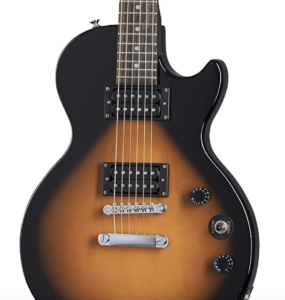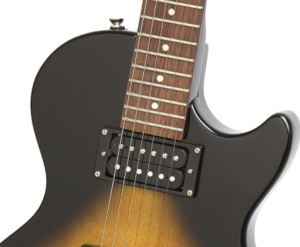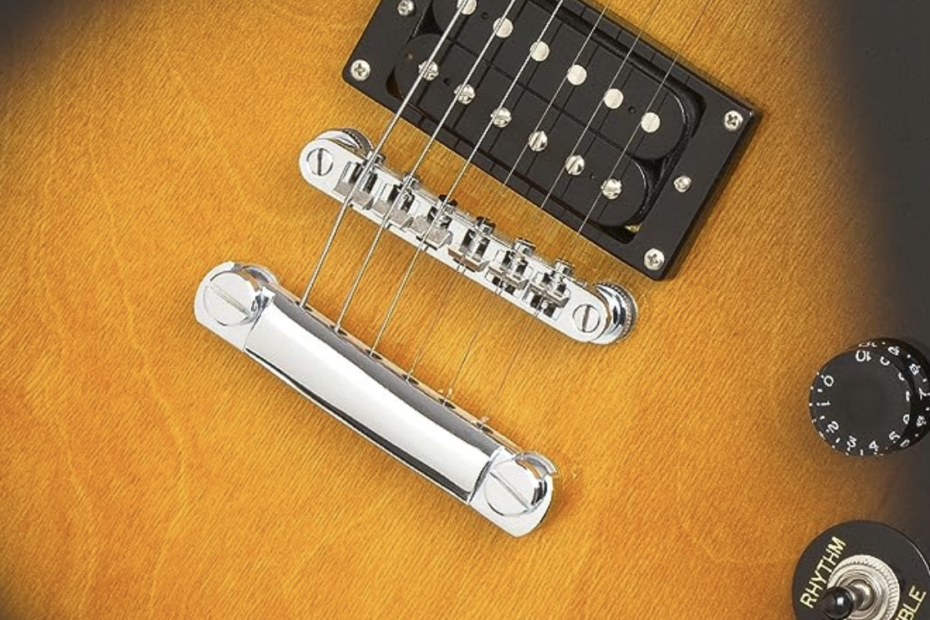The Epiphone Les Paul Special-II is a popular electric guitar model known for its affordability and solid performance. It’s part of the Epiphone Les Paul series, which offers budget-friendly alternatives to the higher-end Gibson Les Paul guitars.
Here are some general features and details about the Epiphone Les Paul Special-II E1 guitar.
Body and Construction
 The Les Paul Special-II typically features a solid body construction made from mahogany, which contributes to its warm and resonant tones. The guitar might also have a maple top, depending on the specific version.
The Les Paul Special-II typically features a solid body construction made from mahogany, which contributes to its warm and resonant tones. The guitar might also have a maple top, depending on the specific version.
The body and construction of a guitar play a significant role in shaping its sound, playability, and overall aesthetic. When it comes to the Epiphone Les Paul Special-II E1 guitar, here are some more details about its body and construction:
- Body Wood: The body of the Epiphone Les Paul Special-II is typically crafted from mahogany. Mahogany is a popular tonewood choice for electric guitars due to its balanced tonal characteristics. It offers a warm and rich sound with good sustain. The choice of mahogany contributes to the guitar’s ability to produce a variety of tones suitable for different music genres.
- Top Wood: Some versions of the Epiphone Les Paul Special-II might feature a maple top. The addition of a maple top can enhance the guitar’s aesthetic appeal and can also slightly influence the tonal characteristics. Maple tops are often associated with a brighter and more defined sound.
- Single-Cutaway Design: The Les Paul Special-II features a single-cutaway body design, which is a hallmark of the Les Paul series. The single cutaway allows for easier access to the upper frets, making solos and high-range playing more comfortable.
- Contoured Body: The body of the guitar often features contoured edges and curves, which contribute to its comfort during playing. These contours allow the guitar to sit snugly against the player’s body, reducing fatigue during longer playing sessions.
- Weight: Mahogany is known for its moderate weight, which results in a guitar that’s not too heavy but still has a substantial feel. This can contribute to the instrument’s resonance and sustain.
- Finish Options: The finish applied to the guitar’s body can vary. Epiphone Les Paul Special-II guitars are typically available in a range of finish options, including solid colors like black, white, red, and sunburst. The finish not only affects the guitar’s appearance but can also influence the way it resonates and projects sound.
- Build Quality: Epiphone is known for producing guitars with good build quality in various price ranges. While the Les Paul Special-II is more affordable compared to higher-end models, it still aims to offer a solid construction that withstands regular playing.
- Overall Sound: The combination of mahogany body and possibly a maple top contributes to the guitar’s versatile sound. You can expect warm and full tones with a good balance between the lows, mids, and highs. The choice of pickups also plays a significant role in shaping the guitar’s tonal characteristics. The guitar follows the classic single-cutaway Les Paul design, with a distinctive shape and comfortable contours.
Also Read:
Schecter Hellraiser C-1 Electric Guitar Review
Godin A6 Ultra : Guitar Review
Jackson Pro Series: Dinky DK Modern Guitar
Guitar Chord Finder: Ultimate Tool
Guitar String Order: How to Remember Easily
Pickups
 The Epiphone Les Paul Special-II E1 guitar typically comes equipped with two open-coil humbucking pickups, which play a crucial role in determining the guitar’s tonal characteristics. Here’s more information about the pickups used in this model:
The Epiphone Les Paul Special-II E1 guitar typically comes equipped with two open-coil humbucking pickups, which play a crucial role in determining the guitar’s tonal characteristics. Here’s more information about the pickups used in this model:
Humbucking pickups, often simply called humbuckers, are designed to reduce or “buck” the hum and noise that can be inherent in single-coil pickups. They achieve this by using two coils wound in opposite directions and connected in a way that cancels out the unwanted noise.
The term “open-coil” refers to the visible design of the pickups, where the coils are not covered by a metal casing or plastic cover. This design choice can contribute to a slightly different tonal character compared to covered pickups, as the coils are exposed to the environment and can interact with the strings more directly.
The humbucking pickups on the Epiphone Les Paul Special-II E1 are likely designed to deliver a balanced and versatile tone. Humbuckers are generally known for their ability to provide a thicker and warmer sound compared to single-coil pickups. They often emphasize the midrange frequencies and offer a more robust low end.
The guitar typically features separate volume and tone controls for each pickup. This configuration allows you to fine-tune the sound of each pickup independently, giving you greater control over your overall tone.
- Pickup Selector Switch: The pickup selector switch, usually located on the guitar’s body, lets you choose between the neck and bridge pickups or a combination of both. This allows you to access different tonal options ranging from warm and mellow (neck) to bright and cutting (bridge), with various possibilities in between.
The humbucking pickups on the Epiphone Les Paul Special-II E1 make the guitar versatile and suitable for various music genres. You can achieve tones ranging from clean and smooth to crunchy and overdriven, making it a good choice for players interested in exploring different styles.
It’s important to note that the specific characteristics of the pickups, such as output level, coil winding, and magnet type, can influence the overall sound of the guitar.
Hardware
 The hardware on the Epiphone Les Paul Special-II E1 guitar encompasses various components that contribute to its playability, tuning stability, and overall functionality.
The hardware on the Epiphone Les Paul Special-II E1 guitar encompasses various components that contribute to its playability, tuning stability, and overall functionality.
The bridge is the part of the guitar that anchors the strings to the body. The Les Paul Special-II E1 often features a fixed bridge design, which provides stability and easy string changing. A well-constructed bridge contributes to accurate intonation and sustain.
The tuners, or machine heads, are responsible for adjusting the tension of the strings to achieve the desired pitch. The guitar is usually equipped with standard die-cast tuners that offer decent tuning stability. Higher-quality tuners can contribute to more precise tuning and longer-lasting stability.
The nut is a small piece located at the top of the neck, near the headstock. It guides the strings to their respective tuning pegs and helps maintain proper spacing between the strings. A well-cut nut is important for smooth tuning and string action.
Some versions of the Epiphone Les Paul Special-II E1 come with a pickguard. The pickguard is a protective plate placed between the pickups and the bridge. It helps guard against scratches and other damage caused by picking and strumming.
Control Knobs and Switches
 The guitar features volume and tone control knobs for each pickup. These knobs allow you to adjust the volume level and tonal characteristics of the individual pickups. Additionally, there is a pickup selector switch that lets you choose between the neck and bridge pickups or a combination of both.
The guitar features volume and tone control knobs for each pickup. These knobs allow you to adjust the volume level and tonal characteristics of the individual pickups. Additionally, there is a pickup selector switch that lets you choose between the neck and bridge pickups or a combination of both.
The strap buttons are where you attach your guitar strap. They are typically located on the upper bout of the guitar body and at the base of the body near the neck joint.
The output jack is where you plug in your guitar cable to connect the guitar to an amplifier or other audio equipment. It’s usually located on the edge of the guitar body.
The hardware components such as the bridge, tuners, and control knobs often come in a chrome or nickel finish. This finish not only adds to the guitar’s visual appeal but also helps protect the hardware from corrosion.
The guitar usually comes strung with a set of strings that’s appropriate for its scale length and tuning. However, you can always experiment with different string gauges to achieve the playability and tone you prefer.
Scale and Fingerboard
The scale length is usually around 24.75 inches, which is a common scale length for Les Paul-style guitars. This contributes to the instrument’s comfortable playability and string tension.
The guitar might feature a mahogany neck with a rosewood fingerboard. The neck profile is often slim and fast, making it easier to navigate the fretboard.
The typical control layout includes volume and tone controls for each pickup, along with a pickup selector switch. This setup allows you to blend the tones of the two pickups and control the overall sound.
Additional Features
- Finish Options: Epiphone Les Paul Special-II guitars come in a range of finish options, including various solid colors and sometimes sunburst finishes.
- Affordability: One of the standout features of the Epiphone Les Paul Special-II is its affordability. It’s aimed at beginners, intermediate players, and those looking for a Les Paul-style guitar without the high price tag of a Gibson Les Paul.
- Suitable for Various Genres: While often associated with rock music, the versatile tones of the Les Paul Special-II make it suitable for a wide range of genres, including rock, blues, pop, and more.
